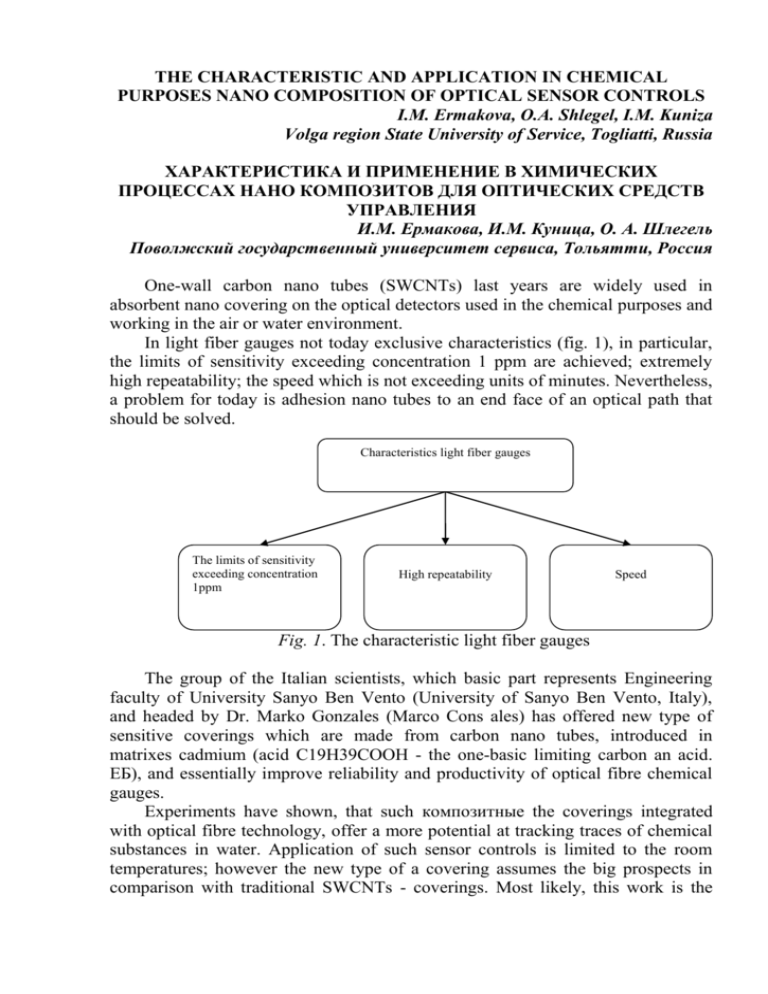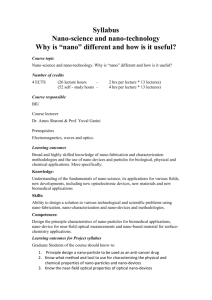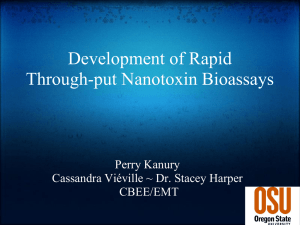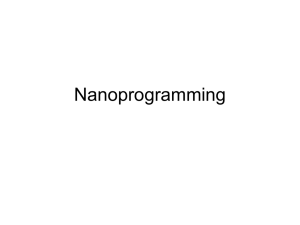THE CHARACTERISTIC AND APPLICATION IN CHEMICAL
advertisement

THE CHARACTERISTIC AND APPLICATION IN CHEMICAL PURPOSES NANO COMPOSITION OF OPTICAL SENSOR CONTROLS I.M. Ermakova, O.A. Shlegel, I.M. Kuniza Volga region State University of Service, Togliatti, Russia ХАРАКТЕРИСТИКА И ПРИМЕНЕНИЕ В ХИМИЧЕСКИХ ПРОЦЕССАХ НАНО КОМПОЗИТОВ ДЛЯ ОПТИЧЕСКИХ СРЕДСТВ УПРАВЛЕНИЯ И.М. Ермакова, И.М. Куница, О. А. Шлегель Поволжский государственный университет сервиса, Тольятти, Россия One-wall carbon nano tubes (SWCNTs) last years are widely used in absorbent nano covering on the optical detectors used in the chemical purposes and working in the air or water environment. In light fiber gauges not today exclusive characteristics (fig. 1), in particular, the limits of sensitivity exceeding concentration 1 ppm are achieved; extremely high repeatability; the speed which is not exceeding units of minutes. Nevertheless, a problem for today is adhesion nano tubes to an end face of an optical path that should be solved. Characteristics light fiber gauges The limits of sensitivity exceeding concentration 1ppm High repeatability Speed Fig. 1. The characteristic light fiber gauges The group of the Italian scientists, which basic part represents Engineering faculty of University Sanyo Ben Vento (University of Sanyo Ben Vento, Italy), and headed by Dr. Marko Gonzales (Marco Cons ales) has offered new type of sensitive coverings which are made from carbon nano tubes, introduced in matrixes cadmium (acid С19Н39COOH - the one-basic limiting carbon an acid. ЕБ), and essentially improve reliability and productivity of optical fibre chemical gauges. Experiments have shown, that such композитные the coverings integrated with optical fibre technology, offer a more potential at tracking traces of chemical substances in water. Application of such sensor controls is limited to the room temperatures; however the new type of a covering assumes the big prospects in comparison with traditional SWCNTs - coverings. Most likely, this work is the first, showing the experimental results confirming opportunities of nano-coverings of similar type at recognition of chemical substances in the water environment. The configuration of the fibre-optical gauge is based on the original circuit interferometer Fabri-feather, formed to fill the air with dust thin sensitive absorbing a liquid nano - covering on an end face typical one fashion optical fibers (fig. 2). The chemical gauge includes absorbing nano - covering at an end face of an optical fiber. Due to changes in a parameter of refraction and thickness of this covering, caused by presence of a chemical impurity in a sample (gas or liquid), their concentration can be determined on changes in reflective ability of a covering Presence of required molecules of chemical substance changes a parameter of refraction and thickness of an absorbing covering. At pass light through an optical fiber, the part of a beam reflected from a covering, appears modeled according to changes in the covering, the caused alien chemical substances. The optical receivers of the radiation recording the reflected beam, scanning it allow defining concentration of an impurity in volume on the certain algorithm. Drawing CdA/ SWCNTs nano compositions on accordingly prepared end face of an optical path process known enough and described in the literature. Scientists used matrixes CdA as a base material because to this material are simultaneously peculiar and waterproof properties, that in this case perfectly corresponds to physics of work interferometer and at the same time is comprehensible for standard techniques of drawing of coverings on end faces of single optical paths. On fig. 3 typical images CdA/ SWCNTs nano compositions, received with the help scanning electronic microscope are resulted. The tendency carbon nano tubes is well visible to gather (to aggregate), forming a sheaf, and at the same time to form good connection (adhesion) with a surface of an optical path, due to assistance CdA. Fig. 2. The chemical gauge ,In work experimental results of research of characteristics light water gauges with CdA/ SWCNTs coverings are resulted. Authors defined concentration of toluene and benzene in water at room temperature. On fig. 3 typical responses of the receiver of radiation are shown at various concentration (20-100 ppm) toluenes in a sample. Absorption of analyzed substance nano compositions a layer results in significant changes in optical properties of a covering. These changes result in essential reduction of reflective ability of a thin film. Experiments have shown an opportunity of the developed opto - electronic device to define to concentration of impurity in the tested samples at a level and with accuracy of units ppm. Thus, good repeatability of results is received and the opportunity of restoration of a primary level of a signal after removal of a chemical impurity is shown. Similar results have been received for benzene in the same ranges of concentration. Fig. 3. Relative changes in reflective ability of coverings from CdA/ SWCNTs, received at various concentration of toluene in water Fig. 4. Characteristic curves of receivers of radiation with a covering nano compositions a layer and without it, received for toluene and benzene. Experiments have shown linear behavior of characteristic curves of the gauge (fig. 5) in experiments with both impurities in all the investigated range of concentration (0-100 ppm). Experiments also have shown typically higher sensitivity of system detection benzene (1.0 × 10−3 ppm−1) in comparison with toluene (4 × 10−4 ppm−1). On fig. 4 sensitivity of system is compared to sensitivity of the gauges using cleanly ОСУН-coverings. Results of experiments testify about essentially higher sensitivity of gauges on composition (CdA/ SWCNTs) a covering: (4 × 10−4 ppm−1) in comparison with standard gauges on carbon nano tubes (1:2 × 10−4 ppm−1). The further work in the given direction and интеграция coverings with optical fibre technologies can open a new direction in practical area of monitoring of quality and cleanliness of water and their fast exit on the market. Literature 1. H.F. Krug et al., nanoECO Book of Abstracts 2–7 March, 2008. - 53 с. 2. M. Scheringer, Nature Nanotechnol., № 3, 2008. – 332 с. 3. Scientific American, v.298, No1, 2008. - 64–71 с. 4. Proc.Third Internat. Forum on Strategic Techn. Novosibirsk-Tomsk, 2008. - 165–166 с. 5. Science, v.315, 2007. - 798–801 с. 6. Physics Education, v.43, No 3, 2008. - 270–279 с. Резюме В статье рассматриваются характеристики и применение нано технологий в оптических средствах управления. Рассматриваются также конкретные случаи, когда необходимо применение нано компонентов. Summary In article the characteristics and application nano of technologies in optical control facilities are considered. The concrete cases are considered also, when the application nano of components is necessary.








